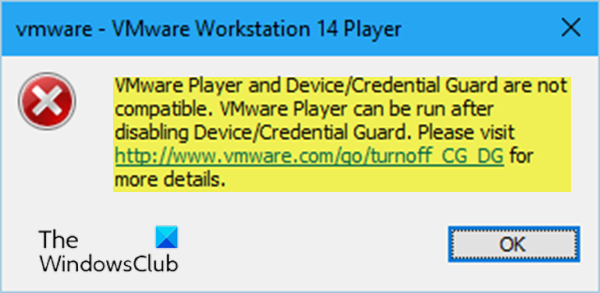VMware Workstation and Device/Credential Guard not compatible
If when you try to power on the VM (Virtual Machine) inside VMware Workstation Player on Windows 10, you lot receive the fault message VMware Workstation and Device/Credential Guard not uniform, and then this post is intended to assistance you. In this post, nosotros will present the solution you can endeavour to aid you resolve this issue.

When you encounter this error, the post-obit full mistake message is displayed;
VMware Player and Device/Credential Guard are non compatible. VMware Player tin be run afterward disabling Device/Credential Guard. Please visit http://world wide web.vmware.com/become/turnoff CG DG for more details.
In Windows ten, Device Guard and Credential Guard are the new security features that are only bachelor on Windows x Enterprise today. Device Guard is a combination of enterprise-related hardware and software security features that, when configured together, will lock a device down and then that it can but run trusted applications. If information technology is not a trusted application, it cannot run. Credential Guard uses virtualization-based security to isolate secrets (credentials) then that only privileged system software tin can admission them. Unauthorized access to these secrets can atomic number 82 to credential theft attacks. Credential Guard prevents these attacks by protecting NTLM countersign hashes and Kerberos Ticket Granting Tickets.
The Pro version of Windows x ships with Hyper-V, the in-firm virtual auto solution from Microsoft built-into Windows. Even so, if you enable Hyper-V, it as well enables the Credential Guard. Disabling the Hyper-V also disable the Credential Guard.
VMware Workstation and Device/Credential Guard non compatible
Based on the error message, yous tin can encounter it indicates VMware Player can be run after disabling Device/Credential Guard. And then, if you're faced with this VMware Workstation and Device/Credential Guard not compatible issue on Windows 10, you can try the two-footstep solution below to resolve the issue.
- Disable Hyper-Five (if enabled)
- Disable the Device Guard Policy via Registry Editor
Let'south accept a look at the description of each step.
one] Disable Hyper-V (if enabled)
To disable Hyper-V, do the post-obit:
- Press Windows key + R to invoke the Run dialog.
- In the Run dialog box, type appwiz.cpl and hit Enter to open up Programs and Features applet.
- In Programs and Features, on the left-hand side, click Turn Windows features on or off.
- In the Plow Windows features on or offpopup that appears, uncheck Hyper-5.
- Click OK.
Hyper-V will at present be disabled from your computer.
- Restart the figurer and on kicking, go on with Step 2.
two] Disable the Device Guard Policy via Registry Editor
Since this is a registry operation, it is recommended that you back upwardly the registry or create a system restore betoken in case the process goes incorrect. Once you accept taken the necessary precautionary measures, you can proceed every bit follows to resolve the VMware Workstation and Device/Credential Guard non compatible issue.
- Press Windows fundamental + R to invoke the Run dialog.
- In the Run dialog box, type regedit and hit Enter to open up Registry Editor.
- Navigate or jump to the registry key path below:
Computer\HKEY_LOCAL_MACHINE\Organisation\CurrentControlSet\Control\DeviceGuard
- On the right pane, double-click the EnableVirtualizationBasedSecurity cardinal to edit its properties.
If you don't see the fundamental, create it by right-clicking on a bare space on the right pane and then select New > DWORD (32-scrap) Value. Rename the value name as EnableVirtualizationBasedSecurity and striking Enter.
- Input 0 in the Value data field and hitting Enter.
- Next, navigate or leap to the registry fundamental path beneath:
Computer\HKEY_LOCAL_MACHINE\Organization\CurrentControlSet\Control\Lsa
- On the right pane, double-click the LsaCfgFlags key to edit its backdrop.
- Input 0 in the Value information field and hit Enter.
You can now exit Registry Editor and restart your arrangement.
You can be able to disable Device Baby-sit policy using the Local Group Policy Editor, every bit well.
Once you have completed the procedure and restarted your computer, the VM should be running fine.
Read side by side: VMware Workstation and Hyper-V are not compatible.

Source: https://www.thewindowsclub.com/vmware-workstation-and-device-credential-guard-not-compatible
Posted by: cutlercomeat.blogspot.com


0 Response to "VMware Workstation and Device/Credential Guard not compatible"
Post a Comment